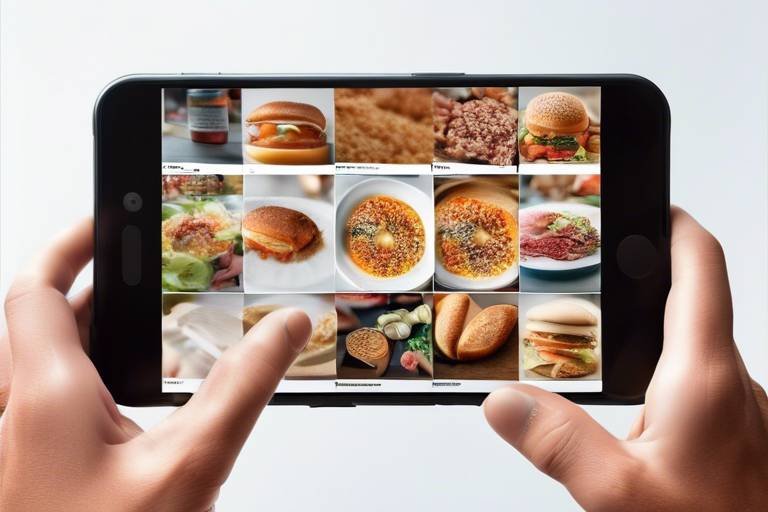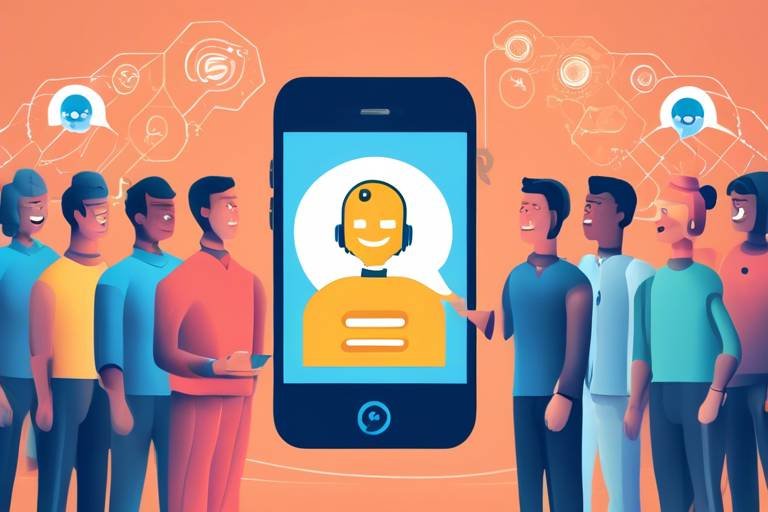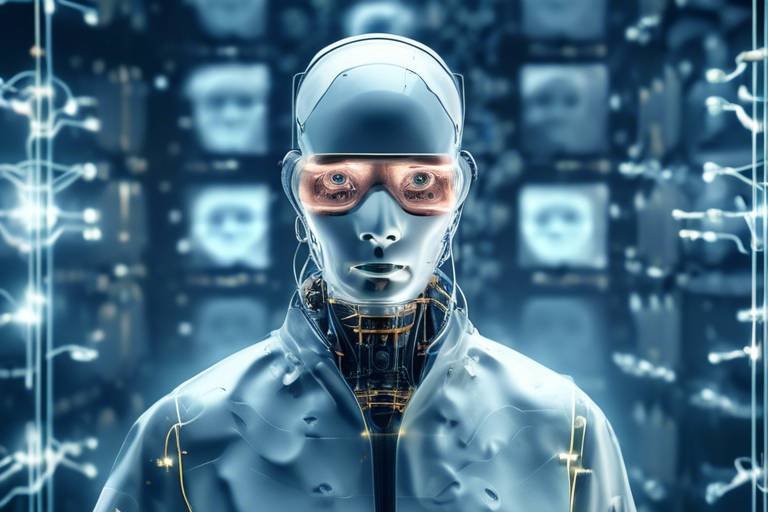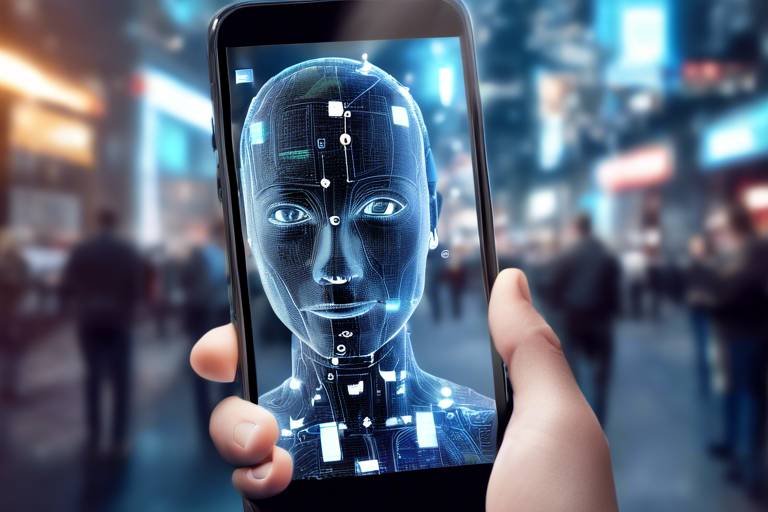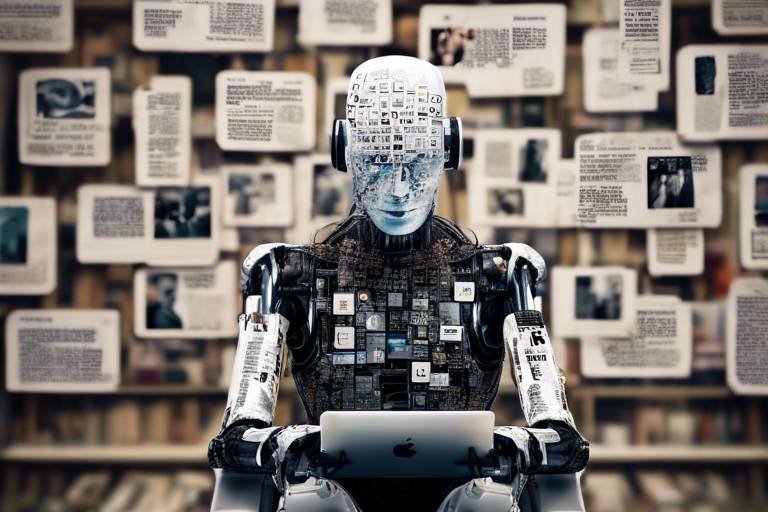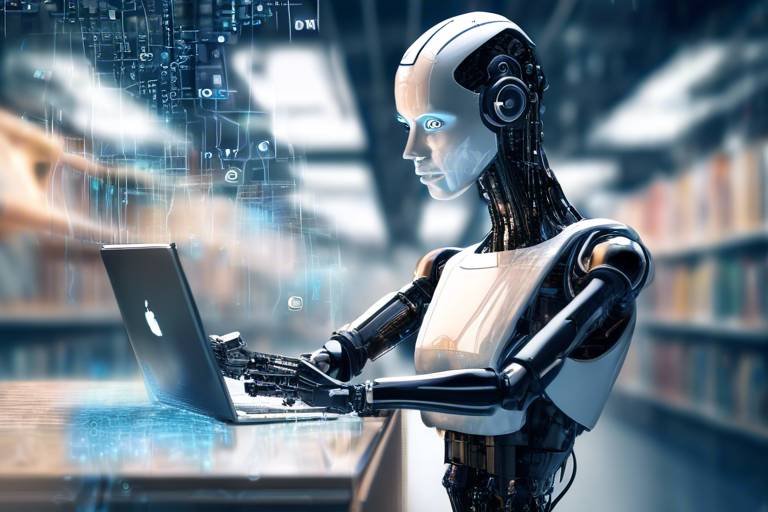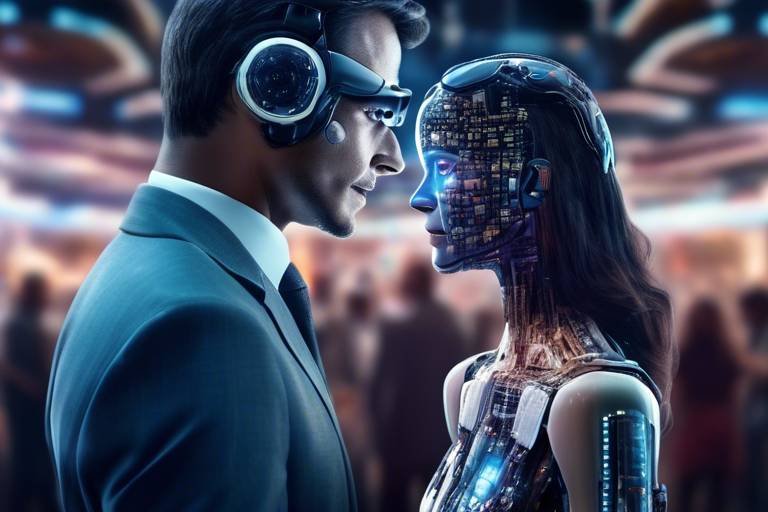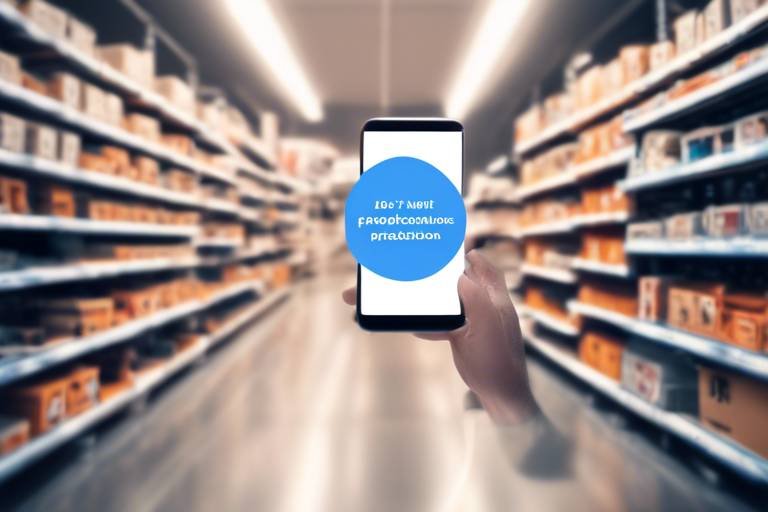How AI is Shaping the Future of the Food Industry
In recent years, the food industry has undergone a seismic shift, largely driven by the advent of artificial intelligence (AI). This technological marvel is not just a buzzword; it's a game changer that is reshaping how we grow, prepare, and consume food. Imagine a world where farmers can predict crop yields with pinpoint accuracy, where grocery stores can anticipate what products will fly off the shelves, and where personalized nutrition is just a click away. That's the future AI is crafting for us, and it’s happening faster than you might think!
From the fields to your plate, AI is enhancing every stage of the food supply chain. In production, we see innovations like precision agriculture, where sensors and data analytics help farmers optimize their inputs, resulting in higher yields and less waste. This means not only more food but also better quality food that meets the demands of an increasingly discerning consumer base.
But it doesn’t stop there. The logistics of food distribution are also being revolutionized. With AI optimizing supply chain management, businesses can ensure that products are delivered on time, reducing spoilage and maximizing freshness. Imagine a world where your groceries arrive at your doorstep, perfectly timed to when you need them, thanks to predictive analytics that forecast demand.
As we dive deeper into this article, we'll explore how AI is not only enhancing production and distribution but also paving the way for a more sustainable and personalized food experience. It's a fascinating journey into the future of food, and you won’t want to miss a single bite!
- What is AI in the food industry?
AI in the food industry refers to the use of artificial intelligence technologies to enhance various processes, from production and supply chain management to customer service and food safety.
- How does AI improve food safety?
AI improves food safety by enabling real-time monitoring systems that detect contaminants and ensure compliance with health regulations, thus protecting consumers from foodborne illnesses.
- Can AI help with personalized nutrition?
Yes! AI-driven dietary apps analyze individual health data to provide tailored meal plans and nutritional advice, promoting healthier eating habits.
- What role does AI play in sustainability?
AI contributes to sustainability by optimizing resource use, reducing waste, and promoting more efficient food production methods that minimize environmental impact.

AI in Food Production
Artificial Intelligence (AI) is revolutionizing the way we approach food production, making it smarter, more efficient, and ultimately, more sustainable. Imagine a world where farmers can predict the exact amount of water their crops need, or where automated systems can harvest fruits and vegetables at the perfect time for optimal freshness. This is not just a dream; it's happening right now, thanks to advancements in AI technologies.
One of the most exciting developments in AI for food production is precision agriculture. This technology utilizes data analytics and machine learning to monitor and manage field variability in crops. By analyzing data from various sources—such as satellite imagery, soil sensors, and weather forecasts—farmers can make informed decisions that enhance crop yield and quality. For instance, by applying the right amount of fertilizers and pesticides only where they are needed, farmers can reduce waste and minimize environmental impact.
Furthermore, AI-driven automated harvesting systems are changing the landscape of agriculture. These systems can operate around the clock, tirelessly working to pick ripe produce without the need for human intervention. This not only increases productivity but also helps in addressing labor shortages that many farms face today. In fact, studies have shown that farms utilizing AI for harvesting can achieve up to a 30% increase in efficiency compared to traditional methods.
Another key area where AI is making a significant impact is through the use of data analytics for crop management. Farmers can now access real-time data on weather patterns, soil conditions, and crop health. This information allows them to make timely decisions that can prevent crop diseases and optimize growth conditions. For example, if a farmer knows that a certain area of their field is experiencing drought conditions, they can allocate resources more effectively to ensure that those crops receive adequate water.
To illustrate the impact of AI in food production, consider the following table that summarizes key benefits:
| AI Technology | Benefits |
|---|---|
| Precision Agriculture | Increased yield, reduced waste, improved soil health |
| Automated Harvesting | Higher efficiency, reduced labor costs, consistent quality |
| Data Analytics | Informed decision-making, disease prevention, resource optimization |
In conclusion, the integration of AI into food production is not just a trend; it's a necessary evolution to meet the demands of a growing global population while ensuring sustainability. As technology continues to advance, we can expect even more innovative solutions that will transform how we grow, prepare, and consume food. The future of food production is bright, and AI is at the forefront of this exciting journey.

Smart Supply Chain Management
In today's fast-paced food industry, artificial intelligence is revolutionizing the way we manage our supply chains. Gone are the days of relying solely on gut feelings and manual processes to predict demand and manage inventory. With AI, businesses can leverage data-driven insights to optimize their operations, ensuring that food reaches consumers in the freshest and most efficient manner possible. Imagine a world where food spoilage is minimized, and every meal is delivered just in time. That’s the power of smart supply chain management!
One of the key benefits of AI in supply chain management is its ability to analyze vast amounts of data quickly and accurately. This includes everything from historical sales data to current market trends. By utilizing predictive analytics, companies can forecast demand with remarkable precision. This means they can stock the right amount of products, reduce waste, and ultimately save money. For instance, if a grocery store knows that demand for avocados spikes during the summer months, they can adjust their inventory accordingly, ensuring they have enough to meet customer needs without overstocking.
Furthermore, AI-driven analytics help businesses streamline their logistics operations. With real-time data on transportation routes, traffic patterns, and weather conditions, companies can make informed decisions that enhance delivery efficiency. For example, if a delivery truck is stuck in traffic, AI can reroute it to avoid delays, ensuring that perishable goods arrive at their destination on time. This not only improves customer satisfaction but also reinforces the brand's reputation for reliability.
Additionally, AI tools provide valuable insights into consumer behavior, allowing businesses to tailor their marketing strategies and product offerings. By analyzing purchasing patterns, companies can identify which products are trending and adjust their supply chain accordingly. This adaptability is crucial in a market where consumer preferences can shift rapidly. For example, if a new health trend emerges, businesses can quickly pivot their inventory to include the latest superfood, ensuring they remain competitive.
To illustrate the impact of AI on supply chain management, consider the following table that summarizes the key benefits:
| Benefit | Description |
|---|---|
| Improved Forecasting | AI analyzes historical data to predict future demand accurately. |
| Reduced Waste | Optimizing inventory levels minimizes food spoilage and waste. |
| Enhanced Efficiency | Real-time data allows for quick decision-making in logistics. |
| Consumer Insights | Understanding purchasing patterns helps tailor products and marketing. |
In summary, AI is not just a buzzword in the food industry; it’s a game-changer for smart supply chain management. By harnessing the power of data and analytics, businesses are transforming the way they operate, ensuring that they can meet consumer demands while minimizing waste and maximizing efficiency. As we move forward, the integration of AI into supply chains will likely become the norm, paving the way for a more sustainable and responsive food industry.
- How does AI improve supply chain efficiency? AI analyzes data to forecast demand, optimize inventory, and streamline logistics, resulting in faster and more reliable delivery of products.
- What role does predictive analytics play in supply chain management? Predictive analytics helps businesses anticipate market trends and consumer needs, allowing for better planning and resource allocation.
- Can AI reduce food waste in supply chains? Yes, by accurately predicting demand and optimizing inventory levels, AI minimizes overstocking and spoilage, leading to less food waste.
- How can businesses adapt to changing consumer preferences using AI? AI tools analyze purchasing patterns and market trends, enabling businesses to adjust their product offerings and marketing strategies accordingly.

Predictive Analytics
In today's fast-paced food industry, is emerging as a game changer, allowing companies to stay ahead of the curve. Imagine having the ability to foresee market trends before they even hit the shelves! This is precisely what AI-driven predictive analytics offers. By analyzing vast amounts of data—from consumer behavior to seasonal trends—businesses can make informed decisions that not only boost their bottom line but also enhance customer satisfaction.
One of the most exciting aspects of predictive analytics is its ability to identify patterns and forecast demand. For instance, consider a restaurant chain that uses data from previous sales, social media trends, and even weather forecasts to predict how many customers will dine in on a given day. This information allows them to optimize staffing levels and ingredient procurement, reducing waste and ensuring that customers receive their favorite dishes without delay. It's like having a crystal ball for business operations!
Moreover, predictive analytics can help food manufacturers streamline their production processes. By analyzing historical data, AI can recommend adjustments to production schedules, ensuring that products are made when they're most likely to sell. This not only increases efficiency but also minimizes the risk of overproduction, which is a significant contributor to food waste. In fact, according to a recent study, companies that implement predictive analytics see a reduction in waste by up to 30%.
Here’s a quick look at how predictive analytics is shaping the food industry:
| Benefit | Description |
|---|---|
| Demand Forecasting | Anticipates customer demand, allowing businesses to adjust their inventory and production accordingly. |
| Waste Reduction | Identifies overproduction risks and helps to minimize waste through better planning. |
| Enhanced Customer Experience | Enables businesses to offer products that align with consumer preferences, leading to higher satisfaction. |
As the food industry continues to evolve, the importance of predictive analytics cannot be overstated. Companies that embrace this technology not only gain a competitive edge but also contribute to a more sustainable and efficient food system. It's a win-win situation where businesses thrive, and consumers enjoy fresher, more relevant food options.
- What is predictive analytics? Predictive analytics involves using historical data and AI algorithms to forecast future trends and behaviors.
- How does predictive analytics benefit the food industry? It helps businesses optimize inventory, reduce waste, and improve customer satisfaction by anticipating demand.
- Can predictive analytics help in sustainability efforts? Yes, by minimizing waste and optimizing resource use, predictive analytics supports sustainability initiatives in food production.

Consumer Behavior Insights
In today's fast-paced world, understanding consumer behavior is more crucial than ever, especially in the food industry. With the integration of artificial intelligence, businesses can dive deep into the minds of their customers, uncovering patterns and preferences that were once hidden. AI tools analyze vast amounts of data, enabling companies to understand not just what consumers are buying, but also why they make those choices. This insight is like having a crystal ball that reveals the shifting tides of consumer demand.
For instance, AI can track trends in purchasing habits, identifying shifts towards healthier options or plant-based diets. By leveraging this data, food companies can tailor their products and marketing strategies accordingly. Imagine a company that notices a spike in demand for gluten-free products; with AI, they can quickly pivot their production to meet this need, ensuring they stay ahead of the competition.
Moreover, AI doesn’t just stop at analyzing past behavior; it also predicts future trends. By employing predictive analytics, companies can anticipate market changes and consumer preferences. This predictive capability allows businesses to make informed decisions about product development, marketing campaigns, and inventory management. For example, if AI indicates a rising interest in sustainable packaging, a company can prioritize this in their product design, appealing to environmentally-conscious consumers.
Additionally, AI tools can segment consumers into various categories based on their buying behaviors. This segmentation allows businesses to create targeted marketing campaigns that resonate with specific groups. For instance, a brand might discover that younger consumers prefer online shopping and are influenced by social media trends. In response, they could launch a targeted social media campaign featuring influencers who align with this demographic's values.
Ultimately, the insights gained from AI-driven consumer behavior analysis empower food businesses to adapt and innovate. By understanding their customers on a deeper level, they can create products that not only meet current demands but also anticipate future needs. This proactive approach is essential in a market that is constantly evolving, ensuring that companies remain relevant and competitive.
- How does AI analyze consumer behavior? AI analyzes consumer behavior by processing large datasets from various sources, including purchase history, social media interactions, and market trends, to identify patterns and preferences.
- What are the benefits of understanding consumer behavior in the food industry? Understanding consumer behavior helps food companies tailor their products, optimize marketing strategies, and anticipate market changes, ultimately leading to increased sales and customer satisfaction.
- Can AI predict future food trends? Yes, AI can predict future food trends by analyzing historical data and current consumer preferences, allowing businesses to stay ahead of the curve.

Market Trend Analysis
In today’s fast-paced world, keeping up with market trends is crucial for any business, especially in the food industry. With the advent of artificial intelligence (AI), companies can now harness the power of data to stay ahead of the curve. AI algorithms analyze vast amounts of data from various sources, including social media, sales records, and consumer feedback, providing businesses with actionable insights. This means they can identify emerging trends before they become mainstream, allowing them to innovate and adapt quickly.
For instance, consider how AI can detect shifts in consumer preferences. If a new superfood starts trending on social media, AI can analyze the spike in mentions and correlate it with sales data to predict whether it’s a fleeting fad or a lasting change in consumer behavior. This kind of predictive capability is invaluable for food companies looking to launch new products or adjust their marketing strategies.
Moreover, AI-driven market trend analysis can help businesses understand regional differences in food preferences. For example, while plant-based diets are gaining traction in urban areas, traditional meat-based diets may still dominate in rural regions. By understanding these nuances, companies can tailor their offerings to meet the specific needs of different demographics.
To further illustrate the impact of AI on market trend analysis, let’s take a look at the following table that summarizes various AI applications in identifying food trends:
| AI Application | Description | Benefits |
|---|---|---|
| Social Media Monitoring | Analyzing social media platforms for trending food topics. | Quick identification of emerging trends. |
| Sales Data Analysis | Evaluating sales patterns to predict future demand. | Informed decision-making for product launches. |
| Consumer Feedback Analysis | Using sentiment analysis on customer reviews. | Understanding consumer satisfaction and areas for improvement. |
By leveraging these AI applications, food companies can gain a competitive edge. They can not only react to current trends but also anticipate future shifts in the market. This proactive approach is essential in an industry where consumer preferences can change overnight. Ultimately, the ability to analyze market trends through AI is transforming how food businesses operate, making them more agile and responsive to the needs of their customers.
- How does AI help in market trend analysis? AI helps by analyzing large datasets to identify patterns and predict future consumer behavior, allowing businesses to make informed decisions.
- What are some examples of AI applications in the food industry? Examples include social media monitoring, sales data analysis, and consumer feedback analysis.
- Can AI predict food trends? Yes, AI can analyze various data sources to forecast emerging food trends, helping companies stay competitive.
- Is AI technology expensive to implement? While initial costs can be high, the long-term benefits of improved efficiency and market insight often outweigh the investment.

Automation in Food Processing
In the bustling world of food processing, automation is not just a trend; it's a revolution. Imagine a factory where machines work in perfect harmony, slicing, dicing, and packaging food with precision that a human hand simply can't match. This is the future that artificial intelligence is helping to create. By integrating AI into food processing, companies are not only enhancing productivity but also ensuring that the quality of food remains consistent across every batch.
One of the most exciting aspects of automation in food processing is the ability to streamline operations. For instance, AI-driven robots can take over repetitive tasks such as sorting and packaging, which allows human workers to focus on more complex and creative roles. This shift not only boosts efficiency but also reduces the risk of human error, which can lead to costly mistakes. In a world where every second counts, this is a game changer.
Moreover, automation in food processing is significantly impacting quality control. Advanced sensors and AI algorithms can monitor every aspect of the production line in real time. They can detect anomalies in texture, color, and even taste, ensuring that only the highest quality products make it to the consumer. Imagine being able to catch a problem before it escalates into a full-blown recall—this is the power of AI in action.
Another critical benefit of automation is its ability to enhance traceability. In an era where consumers are increasingly concerned about the origins of their food, automation can help track every ingredient from farm to table. This transparency not only builds trust with consumers but also helps companies comply with regulatory requirements. A table below illustrates some of the key benefits of automation in food processing:
| Benefit | Description |
|---|---|
| Increased Efficiency | Automation speeds up processes, allowing for higher output in less time. |
| Consistency in Quality | AI monitors production to ensure uniformity in food products. |
| Enhanced Safety | Real-time monitoring reduces risks of contamination and ensures compliance. |
| Cost Reduction | Lower labor costs and reduced waste lead to significant savings. |
| Improved Traceability | Every step of the process can be tracked, enhancing transparency. |
As we look to the future, it's clear that the integration of automation in food processing is not just about replacing human labor; it's about enhancing the entire food production ecosystem. With AI driving these advancements, we can expect to see a more efficient, safer, and sustainable food industry. So, the next time you enjoy a meal, consider the intricate dance of technology and tradition that brought it to your table.
- How does automation improve food safety?
Automation allows for real-time monitoring of the production process, helping to quickly identify and rectify any safety hazards. - What are the cost benefits of automation?
By reducing labor costs and minimizing waste, automation can significantly lower overall production costs. - Will automation replace human jobs in food processing?
While some jobs may be replaced, automation also creates new roles that require human oversight and creativity. - How does AI ensure consistent quality in food products?
AI systems can monitor production parameters continuously, ensuring that each product meets predefined quality standards.

Enhancing Food Safety
In today's world, where food safety is paramount, artificial intelligence (AI) is stepping up to the plate, revolutionizing how we monitor and ensure the safety of our food supply. Imagine a scenario where your food is constantly being checked for contaminants, with real-time alerts sent to manufacturers if something goes awry. This is not science fiction; it's the reality that AI is creating. With the ability to analyze vast amounts of data quickly, AI technologies are becoming indispensable in safeguarding our health and well-being.
One of the most significant advancements in food safety is the implementation of real-time monitoring systems. These AI-driven systems continuously gather data from various points in the food production process, such as temperature, humidity, and contamination levels. By utilizing sensors and machine learning algorithms, these systems can detect anomalies that may indicate potential hazards. For instance, if the temperature in a storage facility rises above a certain threshold, an alert can be triggered, prompting immediate corrective actions. This proactive approach not only helps in preventing foodborne illnesses but also builds consumer trust in food products.
Moreover, AI is enhancing food safety through predictive maintenance. This technology allows food manufacturers to anticipate equipment failures before they occur, thereby minimizing downtime and ensuring a seamless production flow. By analyzing historical data and recognizing patterns, AI can predict when a piece of machinery is likely to fail. This means that maintenance can be scheduled at optimal times, preventing unexpected breakdowns that could lead to unsafe food conditions. Imagine a bakery that can predict when its ovens might malfunction, ensuring that every loaf of bread is baked under perfect conditions. This not only maintains quality but also significantly reduces the risk of contamination.
Furthermore, AI's ability to analyze massive datasets means that it can identify trends in food safety incidents. For example, if a particular type of food product is frequently associated with contamination outbreaks, AI can help pinpoint the source of the problem, whether it's a specific supplier or a particular processing method. This data-driven approach enables companies to make informed decisions that enhance safety protocols and improve overall food quality. As we move forward, the integration of AI in food safety practices will not only protect consumers but also empower businesses to operate more efficiently.
To summarize, AI is fundamentally transforming the landscape of food safety. With tools like real-time monitoring systems and predictive maintenance, the food industry is better equipped to handle the challenges of ensuring safe food for consumers. As we embrace these technologies, the future of food safety looks brighter than ever.
- How does AI improve food safety? AI enhances food safety by providing real-time monitoring, predictive maintenance, and data analysis to identify potential hazards and trends.
- What are real-time monitoring systems? These systems use sensors and AI algorithms to continuously check food conditions, alerting producers to any anomalies that could compromise safety.
- Can AI predict equipment failures? Yes, AI can analyze historical performance data to predict when equipment is likely to fail, allowing for timely maintenance.
- How does AI help in identifying food safety trends? By analyzing large datasets, AI can recognize patterns in food safety incidents, helping companies to improve their protocols and prevent future issues.

Real-Time Monitoring Systems
In the world of food production, powered by artificial intelligence are revolutionizing how we ensure safety and quality. Imagine a scenario where every ingredient that enters a food processing facility is continuously monitored for safety and compliance. This is not just a futuristic concept; it’s happening now! These systems utilize advanced sensors and AI algorithms to collect and analyze data in real-time, providing food manufacturers with immediate insights into their production processes.
One of the most significant advantages of these systems is their ability to detect contaminants and irregularities before they escalate into significant problems. For instance, if a batch of ingredients shows signs of spoilage or contamination, the system can alert operators immediately, allowing for swift action to be taken. This proactive approach not only protects consumers but also minimizes the risk of costly product recalls and reputational damage for brands.
Furthermore, real-time monitoring systems contribute to compliance with health regulations. With food safety standards becoming increasingly stringent, businesses must ensure that they adhere to these regulations consistently. AI-driven monitoring systems can automate compliance checks, ensuring that every aspect of the production process meets the required safety standards. This not only saves time but also reduces the likelihood of human error, which can lead to serious consequences.
To illustrate the effectiveness of real-time monitoring systems, consider the following table that outlines key components and their benefits:
| Component | Benefit |
|---|---|
| AI Sensors | Continuous monitoring of temperature, humidity, and contamination levels. |
| Data Analytics | Instant analysis of production data to identify trends and anomalies. |
| Automated Alerts | Immediate notifications for any deviations from safety standards. |
| Compliance Tracking | Automated documentation for regulatory compliance and audits. |
In essence, real-time monitoring systems represent a critical advancement in the food industry, merging technology with safety practices. They not only enhance operational efficiency but also foster a culture of accountability and transparency within food production. As consumers become more health-conscious and regulations tighten, the demand for such innovative solutions will undoubtedly grow.
- What are real-time monitoring systems? Real-time monitoring systems are AI-driven technologies that continuously track and analyze data related to food safety and production processes.
- How do these systems improve food safety? By detecting contaminants and irregularities instantly, these systems allow for immediate corrective actions, thus preventing potential health risks.
- Can real-time monitoring systems help with regulatory compliance? Yes, they automate compliance checks and documentation, making it easier for businesses to adhere to health regulations.
- What industries can benefit from real-time monitoring systems? While primarily used in the food industry, these systems can also be applied in pharmaceuticals, agriculture, and other sectors where safety is critical.

Predictive Maintenance
Predictive maintenance is revolutionizing the food manufacturing landscape by utilizing artificial intelligence to foresee equipment failures before they occur. Imagine a world where machines can tell you when they need a check-up, just like a car does before a long road trip. This proactive approach not only minimizes downtime but also ensures that production flows smoothly, keeping the supply chain intact and efficient.
At its core, predictive maintenance relies on data analytics and machine learning algorithms to analyze the performance and health of machinery. By continuously monitoring equipment through sensors, AI can detect anomalies that may indicate potential failures. For instance, if a conveyor belt shows signs of wear or an increase in temperature, the system alerts maintenance teams to intervene before a breakdown occurs. This is akin to having a personal trainer who spots your weaknesses and helps you strengthen them before they lead to injury.
One of the most significant advantages of predictive maintenance is its ability to reduce costs associated with unexpected equipment failures. Traditional maintenance strategies often follow a reactive model, where repairs are made only after a machine breaks down. This can lead to costly production halts and emergency repairs. In contrast, predictive maintenance allows companies to schedule maintenance during non-peak hours, optimizing productivity and resource allocation.
To illustrate the impact of predictive maintenance, consider the following table that outlines the differences between traditional and predictive maintenance strategies:
| Aspect | Traditional Maintenance | Predictive Maintenance |
|---|---|---|
| Approach | Reactive | Proactive |
| Cost | Higher due to emergency repairs | Lower due to planned maintenance |
| Downtime | Unpredictable | Minimized |
| Data Usage | Minimal | Extensive |
Moreover, predictive maintenance contributes to enhanced safety in the food industry. By ensuring that equipment operates at optimal levels, the risks associated with machinery failures—such as contamination or accidents—are significantly reduced. This is particularly crucial in food processing, where safety and compliance with health regulations are non-negotiable.
In summary, predictive maintenance is not just a trend; it’s a game-changer for the food industry. By leveraging AI technologies, companies can not only save money but also improve safety and efficiency in their operations. As the industry continues to embrace these innovations, we can expect a future where food production is not only smarter but also more sustainable.
- What is predictive maintenance?
Predictive maintenance is a proactive strategy that uses AI and data analytics to predict when equipment will fail, allowing for timely maintenance and reduced downtime. - How does predictive maintenance benefit the food industry?
It reduces unexpected equipment failures, minimizes downtime, enhances safety, and lowers maintenance costs. - What technologies are involved in predictive maintenance?
Predictive maintenance typically involves sensors, data analytics, and machine learning algorithms to monitor equipment health. - Can predictive maintenance improve food safety?
Yes, by ensuring that machinery operates correctly, predictive maintenance helps reduce risks associated with contamination and other safety hazards.

Personalized Nutrition
In today's fast-paced world, where convenience often trumps health, the concept of personalized nutrition is emerging as a beacon of hope for those seeking to improve their well-being. Imagine a world where your diet is tailored specifically to your unique needs, preferences, and health data. This is not just a dream; it’s a reality made possible by artificial intelligence. AI is revolutionizing how we approach nutrition, transforming generic meal plans into customized dietary solutions that cater to individual lifestyles.
AI-driven dietary apps are at the forefront of this transformation. These innovative tools analyze a plethora of data, from your daily activity levels to your food preferences, and even your health goals. By leveraging this information, they can generate customized meal plans that not only meet your nutritional needs but also fit seamlessly into your lifestyle. For instance, if you're an athlete needing extra protein or someone managing diabetes, these apps can provide tailored recommendations that help you stay on track.
Moreover, the integration of AI with health monitoring devices is a game-changer. Wearable devices that track your heart rate, activity levels, and even sleep patterns can feed real-time data into these nutrition apps. This allows for immediate dietary adjustments based on your current health status. Imagine receiving a notification suggesting a high-fiber snack after a workout or a reminder to hydrate after a long day. This level of personalization ensures that your dietary choices are not only informed but also dynamic, adapting to your needs as they change.
To illustrate how personalized nutrition can impact health, consider the following table that showcases various dietary needs and the corresponding AI-driven solutions:
| Health Condition | Recommended AI Solution |
|---|---|
| Weight Management | Calorie tracking and portion control apps |
| Diabetes | Glycemic index monitoring and meal planning |
| Heart Health | Low-sodium meal suggestions and cholesterol tracking |
| Fitness Goals | Protein intake recommendations and macronutrient balancing |
This table highlights how AI can tailor dietary advice based on specific health conditions, making it easier for individuals to make informed decisions. As we embrace the future of food and nutrition, the potential for AI to enhance our understanding of our dietary needs is truly exciting. Imagine the possibilities of having a personal nutritionist in your pocket, guiding you through every meal and snack!
In conclusion, the rise of personalized nutrition powered by AI is not just about eating better; it's about empowering individuals to take control of their health. As technology continues to evolve, we can expect even more sophisticated tools that will make healthy eating not only easier but also more enjoyable. So, are you ready to embark on your personalized nutrition journey?
- What is personalized nutrition?
Personalized nutrition involves tailoring dietary recommendations to an individual's specific health needs, preferences, and lifestyle, often using data from wearable devices and dietary apps. - How does AI contribute to personalized nutrition?
AI analyzes vast amounts of data to provide customized meal plans and dietary advice, adapting to changes in health status and personal preferences. - Are AI-driven dietary apps safe to use?
Yes, most AI-driven dietary apps prioritize user privacy and data security. However, it’s essential to choose reputable apps and consult with healthcare professionals if needed. - Can personalized nutrition help with weight loss?
Absolutely! Personalized nutrition can create tailored meal plans that promote healthy eating habits, making it easier to achieve weight loss goals.

AI-Driven Dietary Apps
In today's fast-paced world, maintaining a healthy diet can feel like a daunting task. Enter , the game-changers in personalized nutrition! These innovative applications harness the power of artificial intelligence to analyze user data, offering customized meal plans and nutritional advice tailored to individual needs. Imagine having a personal nutritionist right in your pocket, ready to guide you through your dietary choices.
These apps work by collecting various data points from users, including their dietary preferences, health goals, allergies, and even activity levels. By processing this information, the AI can generate meal suggestions that not only meet nutritional requirements but also align with personal tastes. For instance, if you’re trying to cut down on sugar, the app can suggest delicious recipes that satisfy your cravings without compromising your health.
Furthermore, the integration of AI allows these apps to learn and evolve. As you input more data, they become increasingly adept at understanding your habits and preferences. This means that over time, your recommendations become more refined and relevant. It’s like having a dietitian who knows you better with each meal!
To illustrate how these apps function, here’s a brief overview of their key features:
- Personalized Meal Plans: Tailored to your health goals and preferences.
- Nutritional Tracking: Monitor your daily intake of calories, proteins, fats, and carbohydrates.
- Recipe Suggestions: Get inspired with new, healthy recipes that align with your dietary needs.
- Integration with Wearables: Sync with devices like fitness trackers to adjust dietary recommendations based on activity levels.
Moreover, these dietary apps often include features that promote community engagement. Users can share their progress, exchange recipes, and even challenge each other to meet health goals. This sense of community can be incredibly motivating, making healthy eating feel less like a chore and more like a fun journey.
In summary, AI-driven dietary apps are revolutionizing the way we approach nutrition. They empower individuals to make informed dietary choices, support healthier lifestyles, and adapt to personal preferences. With technology evolving at such a rapid pace, the future of personalized nutrition looks brighter than ever!
If you have questions about AI-driven dietary apps, here are some common inquiries:
- Are AI-driven dietary apps safe to use? Yes, most reputable apps prioritize user privacy and data security, ensuring that your personal information remains confidential.
- Can these apps help with specific dietary restrictions? Absolutely! Many apps are designed to cater to various dietary needs, including vegan, gluten-free, and low-carb diets.
- Do I need to pay for these apps? While some apps offer free versions, many provide premium features for a subscription fee.
- How accurate are the nutritional recommendations? AI-driven dietary apps use extensive databases and algorithms to provide accurate nutritional recommendations, but it's always good to consult with a healthcare professional for personalized advice.

Health Monitoring Integration
In today's fast-paced world, maintaining a healthy lifestyle can often feel like a daunting task. However, thanks to the integration of artificial intelligence (AI) with health monitoring devices, achieving personal health goals has never been easier. Imagine having a personal nutritionist in your pocket, ready to provide tailored advice based on your unique dietary needs and health data. This is the promise of AI-driven health monitoring integration.
AI-powered applications can analyze a plethora of data points collected from wearable devices, such as smartwatches and fitness trackers. These devices monitor various health metrics, including heart rate, activity levels, sleep patterns, and even blood glucose levels. By combining this data with AI algorithms, users receive real-time dietary recommendations that adapt to their daily activities and overall health.
For instance, if a user has an active day planned, the AI can suggest meals rich in carbohydrates to fuel their energy needs. Conversely, on a more sedentary day, the app might recommend lighter meals to avoid excess calorie intake. This level of personalization not only makes healthy eating more accessible but also promotes better health outcomes by ensuring that individuals consume the right nutrients at the right times.
Moreover, the integration of AI with health monitoring devices opens up a new realm of possibilities for preventive health care. By continuously analyzing data, AI can identify patterns that may indicate potential health issues before they become serious. For example, if a user's sleep quality declines consistently over a week, the AI might recommend dietary changes or lifestyle adjustments to improve sleep, thus preventing longer-term health problems.
To illustrate the effectiveness of this integration, consider the following table that outlines some common health metrics tracked by devices and the corresponding AI-driven dietary recommendations:
| Health Metric | AI-Driven Recommendation |
|---|---|
| Heart Rate | Increase hydration and consume potassium-rich foods (e.g., bananas, avocados) |
| Sleep Quality | Incorporate magnesium-rich foods (e.g., nuts, leafy greens) and avoid caffeine |
| Activity Level | Consume protein-rich meals to aid muscle recovery |
| Blood Glucose Levels | Opt for low-glycemic index foods (e.g., whole grains, legumes) |
As we move forward, the potential for AI in health monitoring integration is vast. With advancements in technology, we can expect even more sophisticated algorithms that provide deeper insights into our health. This means more personalized and effective dietary recommendations that cater to our lifestyles. The future of nutrition is not just about what we eat but also about understanding how our bodies respond to what we consume, thanks to AI.
In conclusion, the integration of AI with health monitoring devices is revolutionizing the way we approach nutrition and health management. By leveraging real-time data and personalized insights, individuals can make informed choices that enhance their well-being. It's like having a health coach that never sleeps, always ready to guide you toward a healthier lifestyle.
- How does AI personalize dietary recommendations? AI analyzes data from health monitoring devices to understand individual health metrics and preferences, allowing it to tailor dietary advice accordingly.
- Can AI help prevent health issues? Yes, by identifying patterns in health data, AI can suggest lifestyle changes that may prevent potential health problems.
- What types of health metrics can be monitored? Common metrics include heart rate, sleep quality, activity levels, and blood glucose levels, among others.
- Are AI dietary apps easy to use? Most AI dietary apps are designed with user-friendliness in mind, making it easy for anyone to track their health and receive personalized advice.

Sustainability in Food Systems
The food industry is undergoing a remarkable transformation, and at the heart of this change is the quest for sustainability. As we face increasing challenges such as climate change, resource depletion, and a growing global population, the need for sustainable food systems has never been more critical. AI technologies are stepping up to the plate, driving initiatives that promote resource efficiency and reduce the environmental impact of food production and distribution. Imagine a world where we can produce food in a way that not only meets our needs but also protects our planet for future generations. Sounds like a dream, right? Well, with AI, that dream is becoming a reality.
One of the most significant contributions of AI to sustainability in food systems is its ability to optimize resource use. For instance, AI algorithms can analyze vast amounts of data to determine the precise amount of water, fertilizer, and energy needed for crop production. This level of precision helps farmers to minimize waste and maximize yield, making their operations not only more productive but also more environmentally friendly. In fact, studies have shown that farms using AI-driven resource management can reduce water usage by up to 30% while improving crop output.
Moreover, AI is playing a pivotal role in waste reduction strategies throughout the food supply chain. By implementing AI-driven analytics, companies can identify inefficiencies and pinpoint areas where waste occurs. For example, AI can predict demand with remarkable accuracy, helping retailers manage their inventory more effectively and reduce the surplus that often ends up in landfills. According to the Food and Agriculture Organization (FAO), approximately one-third of all food produced globally is wasted. By leveraging AI, we can significantly cut down on this staggering statistic.
Additionally, AI technologies are facilitating sustainable practices in food distribution. With the help of machine learning algorithms, logistics companies can optimize delivery routes, reducing fuel consumption and minimizing carbon emissions. This not only leads to cost savings for businesses but also contributes to a cleaner environment. Imagine a delivery truck that knows the best route to take, avoiding traffic and minimizing stops—this is the power of AI in action.
To further illustrate the impact of AI on sustainability, consider the following table that summarizes key benefits:
| AI Application | Benefit |
|---|---|
| Resource Optimization | Reduces water and energy usage by analyzing crop needs. |
| Waste Reduction | Minimizes food waste by improving demand forecasting. |
| Logistics Optimization | Enhances delivery efficiency, reducing carbon footprint. |
As we move forward, the integration of AI into our food systems is not just a trend; it’s a necessity. The intersection of technology and sustainability holds the key to addressing some of the most pressing challenges we face today. By embracing these innovations, we can create a food system that is not only efficient and productive but also responsible and sustainable.
- How does AI help reduce food waste?
AI analyzes purchasing patterns and inventory levels to optimize stock levels and reduce overproduction. - Can AI contribute to organic farming?
Yes, AI can help organic farmers use resources more efficiently while maintaining compliance with organic standards. - What role does AI play in sustainable packaging?
AI can analyze material usage and suggest alternatives that are more environmentally friendly.

Waste Reduction Strategies
The food industry faces a significant challenge when it comes to waste management. In fact, it's estimated that approximately one-third of all food produced globally is wasted. This staggering statistic highlights the urgent need for effective waste reduction strategies. Artificial Intelligence (AI) is stepping up to the plate, offering innovative solutions that can help minimize waste across the entire food supply chain.
One of the primary ways AI contributes to waste reduction is through data-driven insights. By analyzing consumption patterns, AI can predict demand more accurately. This means that food producers can adjust their production schedules accordingly, reducing the likelihood of overproduction and subsequent waste. For instance, if AI identifies a trend in consumer preferences for plant-based products, producers can shift their focus to meet that demand, thereby minimizing surplus of less popular items.
Additionally, AI technologies are enhancing the efficiency of inventory management. Traditional inventory systems often lead to excess stock, which can go bad before it’s sold. With AI, businesses can implement just-in-time inventory systems, ensuring that products are delivered only as needed. This not only cuts down on waste but also reduces storage costs and improves cash flow. Imagine a grocery store that receives fresh produce daily, perfectly timed to meet customer demand—this is the power of AI in action!
Moreover, AI can optimize food processing techniques to minimize waste. For example, AI-powered machinery can adjust processing speeds and methods based on real-time data, ensuring that every part of the ingredient is utilized efficiently. This is especially crucial in the production of processed foods, where by-products can often be discarded. Instead, AI can help find new uses for these by-products, such as converting them into animal feed or bioenergy.
Another exciting application of AI in waste reduction is through smart packaging solutions. AI can help develop packaging that monitors the freshness of food products. For example, smart sensors can detect when food is nearing its expiration date and alert consumers, prompting them to consume it before it goes bad. This not only helps reduce household waste but also encourages consumers to be more mindful of their food purchases.
To illustrate the impact of these strategies, consider the following table showcasing the potential waste reduction percentages achieved through AI implementations:
| Strategy | Potential Waste Reduction (%) |
|---|---|
| Demand Forecasting | 20-30% |
| Inventory Optimization | 15-25% |
| Processing Efficiency | 10-20% |
| Smart Packaging | 5-15% |
In conclusion, AI is revolutionizing waste reduction strategies in the food industry by enhancing efficiency, optimizing processes, and promoting smarter consumer choices. As these technologies continue to develop, the potential for reducing waste not only benefits businesses but also contributes significantly to a more sustainable future. By embracing AI, we can ensure that fewer resources are wasted, creating a food system that is both economically viable and environmentally friendly.
- How does AI help reduce food waste?
AI helps by predicting demand, optimizing inventory, and improving processing techniques, which collectively minimize surplus and waste. - What are smart packaging solutions?
Smart packaging solutions use sensors to monitor food freshness and alert consumers about expiration dates, helping to reduce household waste. - Can small businesses benefit from AI waste reduction strategies?
Absolutely! Small businesses can leverage AI tools to optimize inventory and production processes, making waste reduction accessible to all.

Resource Optimization
In today's fast-paced world, has emerged as a crucial pillar in the food industry, driven by the capabilities of artificial intelligence. Imagine a world where every drop of water and every kilowatt of energy is used efficiently—this is not just a dream, but a reality that AI is helping to create. By leveraging advanced algorithms and real-time data analytics, businesses can significantly enhance their resource management strategies.
AI technologies analyze vast amounts of data to identify patterns and inefficiencies in resource usage. For instance, in agriculture, AI can determine the precise amount of water needed for irrigation, reducing waste and ensuring that crops receive just the right amount of hydration. This not only conserves water but also enhances crop yield and quality. Similarly, in food processing, AI can optimize energy consumption by adjusting machinery operations based on real-time demand, leading to substantial cost savings.
Moreover, AI-driven systems can forecast resource needs, allowing companies to plan more effectively and minimize surplus. This predictive capability means that businesses can avoid over-purchasing or under-utilizing resources, which often leads to waste. For example, AI can analyze historical data to predict the optimal amount of raw materials required for production, ensuring that resources are allocated efficiently without compromising quality.
Additionally, AI can facilitate better logistics in the supply chain, ensuring that resources are used efficiently throughout the entire process—from production to distribution. By optimizing routes for transportation, AI helps reduce fuel consumption and carbon emissions, contributing to a more sustainable food system.
In summary, resource optimization through AI not only promotes sustainability but also enhances profitability for businesses. As the food industry continues to evolve, the integration of AI in resource management will be pivotal in addressing the challenges of sustainability and efficiency. The future of food production is not just about growing more; it's about growing smarter.
- What is resource optimization in the food industry?
Resource optimization refers to the efficient use of resources such as water, energy, and raw materials in food production and distribution, often enhanced by AI technologies.
- How does AI contribute to sustainability in food systems?
AI helps identify inefficiencies, predict resource needs, and optimize logistics, leading to reduced waste and lower environmental impact.
- Can AI improve crop yields?
Yes, AI technologies can analyze data to provide insights into optimal farming practices, leading to improved crop yields and quality.
- What are some examples of AI applications in resource optimization?
Examples include precision irrigation systems, energy management in food processing, and predictive analytics for inventory management.
Frequently Asked Questions
- How is AI transforming food production?
AI is revolutionizing food production by enhancing efficiency and reducing waste. Through precision agriculture, farmers can monitor crop health in real-time, leading to improved crop yields and quality. Automated harvesting technologies powered by AI are also streamlining the harvesting process, making it faster and more efficient.
- What role does AI play in supply chain management?
AI optimizes supply chain logistics by ensuring timely delivery and minimizing food spoilage. Using AI-driven analytics, businesses can accurately forecast demand and manage their inventory more effectively, which helps in reducing waste and improving profitability.
- How does AI contribute to food safety?
AI applications in food safety monitoring are crucial for detecting contaminants and ensuring compliance with health regulations. Real-time monitoring systems provide critical data that allows for immediate responses to potential hazards, thereby protecting consumers from foodborne illnesses.
- Can AI help with personalized nutrition?
Absolutely! AI is paving the way for personalized nutrition solutions by offering tailored dietary recommendations based on individual health data and preferences. AI-driven dietary apps analyze user data to create customized meal plans, making healthy eating more accessible and enjoyable.
- What sustainability benefits does AI provide in the food industry?
AI drives sustainability initiatives by promoting resource efficiency and reducing the environmental impact of food production and distribution. It helps identify waste reduction opportunities and optimizes the use of resources like water and energy, contributing to more sustainable practices in the food industry.

